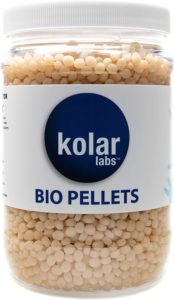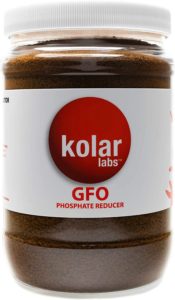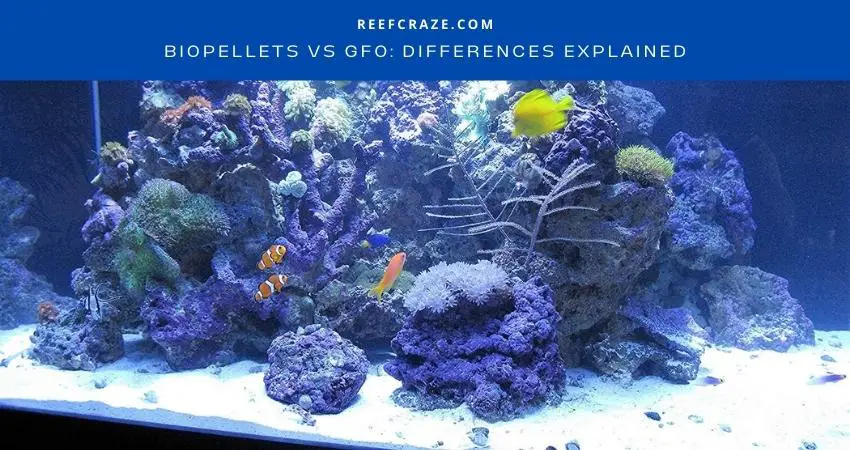Biopellets and GFO are essential mechanisms to keep your tank environment safe and healthy for your fish friends. Both have similar tasks with some differences that new reefers may not know due to their lack of experience. So here goes an intro session for biopellets VS GFO.
The prime difference between a GFO reactor and biopellets is in their activities. A GFO reactor decreases phosphates to control algae growth in saltwater and freshwater tanks. On the other hand, biopellets are a natural and pure carbon dosing technique that does the same thing and additionally removes nitrates.
But learning that is merely not enough for newbies. So, I decided to discuss their differences by mentioning each aspect individually. Let’s see what we have there.
What Are Biopellets? What Is A GFO Reactor?
Biopellets are tiny, biodegradable pellets containing bacteria to keep your tank thriving.
A tank needs a good amount of bacteria to create a healthy ecological balance and keep phosphate and nitrate levels stable. A tank loaded with nitrates can be a victim of excessive algae growth, losing aquatic life consequently.
GFO (Granular Ferric Oxide) is a chemical filtration mechanism incorporated in a reactor to hinder algae growth by eliminating phosphates from reef tanks.
Biopellets Vs. GFO: What Do They Do?
Biopellets

A biopellet reactor houses biopellets, where they develop a solid population of beneficial bacteria. There they can live, repopulate, and clean your aquarium of unwanted substances.
The reactor holds a specific amount of biopellets that degrade and release helpful bacteria while feeding the existent bacteria altogether.
In a nutshell, the biopellet reactor acts as a backup system to shelter your non-existing or existing biological filtration mechanism. It helps develop and maintain healthy bacteria populations necessary for your tank to filter nitrates. It will also eliminate ammonia and nitrate from the water.
GFO

In a saltwater aquarium, a GFO reactor works as an efficient and safe way to remove silicates and phosphates from the tank water. When it lowers phosphate levels, it halts algae outbreaks and their growth.
Additionally, the reactor also absorbs molybdenum, antimony, arsenic, fluoride, and more. All of that contributes to the well-being of your tank environment.
How Do Biopellets And GFO Work?
Biopellets
The functionality of a biopellet reactor is simple. Submerged in the tank water, it uses an intake tube to pull in water.
When the water passes the pellets, hence the bacteria, they filter out nitrates, ammonia, and nitrites. After the filtering, an outtake pump sends the purified water back into your tank.
GFO
It follows the steps of adsorption, where chemicals like silicates and phosphates adhere to the media surface. The adsorption process is different from absorption.
In this process, the substances diffuse into solid or liquid forms to formulate a solution.
How To Set Up Biopellets?
Step 1: Select the reactor well-suited for the size and shape of your reef tank. The larger it is, the more pellets and the larger reactor you will need.
Step 2: Fill the reactor with as many bio pellets as your tank needs. You may need to research to learn the quantity. For example, for every 50 gallons of water, you can take a cup of pellets.
Step 3: The pellets will generate bacteria and feed them after releasing themselves. However, you can also purchase and mix some bacteria to speed up the process.
You can find liquid biological bacteria online and in your local aquarium stores. Although it is not essential, it will magnify the process and make the outcome more effective.
Step 4: Place the reactor in a suitable location in the aquarium before turning it on. Then you are all set.
You will need to bring in new pellets twice a year to get the reactor running at its full power.
How To Set Up GFO?
While setting up the reactor, keep its pump separate from the pump of your protein skimmer. The best option is to put the reactor into your sump’s return section.
However, make sure there is enough space around that return tube for the effluent. It secures that you will not spend time in vain by retreating the tank water that has passed through the process already.
Here is a piece of information you will need. Use a single tablespoon of GFO for each 4 water gallons in the beginning. If everything works out well, increase it to 2 tablespoons for the same quantity of water for treating.
How Long Do They Take To Work?
Biopellets take one to two months for the bacteria to populate and start working on the nitrate level. That also depends on your reef system.
Once the reactor starts functioning, do not make new adjustments for two months. Give the bacteria and media some time to comply with the existing water parameters in your aquarium and start working.
It is pretty much the same for GFO too.
Can I Run Biopellets And GFO Together?
Yes, but in different reactors. However, you may need to remove the GFO from the tank system if the phosphate levels are low.

Which One Is Better: Biopellets Or GFO?
So here comes the moment of truth. Let me explain some things first before jumping to a conclusion.
As mentioned already, biopellets handle phosphates, nitrates, nitrites, and ammonia altogether. It helps pace the nitrogen cycle up in the inception of your reef system. That means you will not have to wait for the cycle completion to add fish. Plus, your tank water will be ammonia-free and clean.
In addition, it makes up for what inefficiencies many filtration systems suffer. If there are many plants and fish, your filters may not support them sufficiently. So, biopellets do an excellent job at backing up when ammonia levels spike.
The thing with GFO is that while it comes with bountiful good stuff, there are some hidden costs in disguise.
For example, GFO can eliminate key trace components like copper and manganese. Excessive levels of these elements are detrimental to the tank’s inhabitants. But a few of them should also be there for their well-being.
The same thing applies to phosphates. GFO eliminates phosphates too fast. Although increased levels of phosphates are not good for corals, they also need some of it to stay healthy.
Again, the dust of GFO can irritate coral polyps and fish gills.
Now, all the issues here are solvable, which will require you to take care of the GFO reactor (an extra job) and change your tank water more regularly than you would have to without the GFO.
It has its advantages, but the disadvantages are worth your consideration, especially when you can get biopellets to do the job of a GFO reactor. (Note that biopellets too need maintenance, of course.) But GFO cannot alone do what biopellets do.
So, to sum it up, biopellets have my vote.
Final Words
Both biopellets and GFO do the same thing, but biopellets are extra. You know what I mean?
So, considering the advantages and maintenance they offer and require, biopellets seem a better option. But understand that they are not mutually exclusive. You can use both with different reactors.
I hope this Biopellets VS GFO discussion was helpful for you. Happy Reefing!
